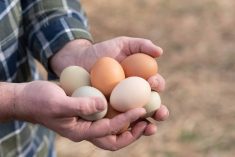Last month, I was happy to see BASF’s announcement of the second year of its Safety Scouts program. The purpose of the program is to support farm safety for children and their families by inviting kids to act as safety ambassadors on their family farms. This year, 2,000 Safety Scouts Kits will be available for farm families across Canada free of charge while supplies last.
The tool kit includes an adjustable, CSA Z96-15-compliant child-sized safety vest, a customizable name badge, safety-themed activity and colouring sheets, BASF Safety Scouts reward badge and an official BASF Safety Scouts membership certificate.
The program was created to keep farm safety top of mind for parents, guardians and children, and to instil the values of safety in children from a young age. The kits engage young children through fun and interactive activities to encourage lifelong habits, skills and focus on safety. You can register for the kits at the BASF website, where you will also find other safety resources.
Read Also

Gentle treatments for pain in the neck
Heading toward year-end, people unknowingly tense up against the cold and busyness, causing neck pain that can often be treated with appropriate support and gentle mobility, athletic therapist Kathlyn Hossack says.
We are not doing enough
While there has been more attention on farm safety, according to a Canadian Agricultural Safety Association (CASA) infographic, on average five children die each year on Canadian farms based on data from 2002-2012. You may think the numbers of child farm fatalities per year have dropped in recent years. However, you would be wrong.
Four child farm fatalities were reported by mainstream media in 2021. Each one of those deaths last year is tragic and heartbreaking, and I can’t imagine the pain those families are going through.
Also from the data above, it was startling to see the majority of children killed on the farm are boys (80 per cent). This has me wondering why we’re putting male children in positions that lead to significantly higher rates of death than female children. Could we be placing boys, because of their gender, in more dangerous situations?
Additionally, 36 per cent of the fatalities were children under the age of five, and 72 per cent of the total farm fatalities were the children of the farm operators. I know these numbers are difficult to read and think about as our children mean everything to us. It is a difficult topic to write about as well. However, I write about it at this time, when farming operations are gearing up for another season, as a reminder that these accidents still happen to children under the age of five, and who are not yet in school, and those who are older, and who may be helping out this summer on the farm.
A detailed 2020 report by Canadian Agricultural Injury Reporting and CASA called, “Child and Youth Agriculture-Related Fatalities in Canada 2006-2015,” showed over a 26-year period (1990-2015), the fatality rate for children remained constant — with a slight increase of 0.2 per cent each year. Again, these numbers tell us we are not doing enough to stop child fatalities on farms.
It also reported similar numbers to the data from 2002-2012 mentioned above — 74 per cent of the agriculture-related child and youth fatalities were male and children less than five years of age had the highest fatality rate of 11.1 fatalities per 100,000 farm population. It is clear, how we think about child safety on the farm must change. I don’t have the answers for you about how it needs to change but I do know why it needs to change: even one child’s death is too many.
Resources
What I can do is offer you a roundup of resources and links to read as we head into another crop production season. All of this material, in total, took me about 45 minutes to read. If you have children, it could be the most important 45 minutes you spend this year. The resources listed below may provide you with insights as to where your on-farm child safety initiatives are strong or weak. There are some excellent tools to help you assess child safety risks on your farm, how to determine what your youth is safely capable of doing around the farm this year, and how to reduce the risk your child will be hurt in an on-farm incident.
There are many more resources on the internet than I have listed below, but here is a place to start for assessing and improving safety on your farm for your children.
For parents and guardians:
- “Creating Safe Play Areas for Kids” (opens as a PDF)
- “Ag Youth Work Guidelines”
- “Farm Safety for Children”
- To join and participate in Safety Days in your community (CASA-ACSA website)
- “North American Guidelines for Children’s Agricultural Tasks — Driving a Farm Tractor No Implement Attached” (CASA-ACSA website)
- The infographic “Driving a Farm Tractor No Implement Attached” (opens as a PDF)
- “Child and Youth Agriculture-Related Fatalities in Canada” (CASA-ACSA website)
For parents, guardians and children:
- “Farm Safety Resources for Kids” (CASA-ACSA website)
- “Toolbox Talks for Kids: Playing Safe on the Farm” (opens as a PDF)
- “Farm Safety Contract for Kids and Parents” (CASA-ACSA website)
Keep your kids safe and if they’re going to help out this year, assign them age- and ability-appropriate tasks.
Best wishes for a great growing season,
Kari
















